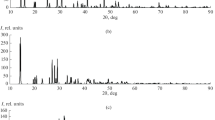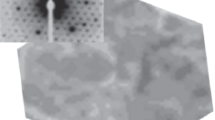Abstract
If anilinium ions are intercalated into Llano vermiculite, the stacking order of adjacent silicate layers is increased, resulting in a relatively sharp single crystal X-ray diffraction (XRD) pattern. The packing of intercalated organic members forms a superstructure and produces bonding from layer to layer which favors the stacking order. Superlattice reflections occur which, although sharp in the a*b* plane, are streaked along c*. Apparently there is little coherence between adjacent layers of ordered organic units.
A three-dimensional set of XRD reflections for a triclinic sub-cell having the following lattice parameters was measured: a = 5.326(3), b = 9.264(4), c = 14.82(5) Å, α = 90.31(7), β = 96.70(6), and γ = 89.55(5)°. In this unit cell (symmetry Cl), ditrigonal cavities in adjacent silicate layers are approximately opposite. Differential Fourier analyses and least-squares refinements showed that the principal axes of the anilinium ions, i.e., N-C(1)-C(4), are nearly perpendicular to the silicate layers. The planes of the aromatic rings, however, are about ±30° to X, neither parallel nor perpendicular to that direction, as indicated by earlier studies.
Inorganic cations and water molecules are also present in the interlayer; the former and some of the latter occupy sites near the middle of the layer. Anilinium-rich and anilinium-poor domains coexist. In the latter, the cation-water system predominates and apparently conforms to the superstructure. Although the cation-water structure could not be uniquely established from the reflections produced by the sub-cell, possible positional coordinates were obtained. From structural data for the silicate layers, no evidence was found for long-range Si/Al ordering in the tetrahedral sites.
Similar content being viewed by others
References
Brown, C. J. (1949) The crystal structure of aniline hydrochloride: Acta Crystallogr. 2, 228–232.
Busing, W. R., Martin, K. O., and Levy, H. A. (1962) ORFLS, a Fortran crystallographic least-squares program: Oak Ridge Natl. Lab. Tech. Mem. 305, Oak Ridge National Laboratory, Tennessee, 75 pp.
de la Calle, C., Suquet, H., and Pezerat, H. (1985) Vermiculites hydratées à une couche: Clay Miner. 20, 221–230.
Guss, J. M., Nockolds, C. E., and Wood, A. M. (1970) User manual for a computer-controlled BUERGER-SUPPER equi-inclination X-ray diffractometer: Crystal Structure Laboratory, School of Chemistry, Univ. Sydney, Sydney, Australia, 34–35.
Hazen, R. M. and Burnham, C. W. (1973) The crystal structures of one-layer phlogopite and annite: Amer. Mineral. 58, 889–900.
International Tables for X-ray Crystallography (1974) Vol. IV: Kynoch Press, Birmingham, United Kingdom, 72–78.
Mathieson, A. McL. and Walker, G. F. (1954) Crystal structure of magnesium-vermiculite: Amer. Mineral. 39, 231–255.
Motherwell, W. D. S. (1978) PLUT078. A plotting program for Cambridge crystallographic data: Chemical Laboratory, Cambridge Univ., Cambridge, United Kingdom, 26 pp.
Nitta, I., Watanabe, T., and Taguchi, I. (1948) The crystal structure of aniline hydrobromide: X-Sen 5, 31–36.
Raupach, M., Slade, P. G., Janik, L., and Radoslovich, E. W. (1975) A polarized infrared and X-ray study of lysinevermiculite: Clays & Clay Minerals 23, 181–186.
Sheldrick, G. M. (1976) SHELX. Program for crystal structure determination: Cambridge Univ., Cambridge, United Kingdom, 150 pp.
Shirozu, J. and Bailey, S. W. (1966) Crystal structure of a two layer Mg-vermiculite: Amer. Mineral. 52, 1124–1143.
Slade, P. G. and Raupach, M. (1982) Structural model for benzidine-vermiculite: Clays & Clay Minerals 30, 297–305.
Slade, P. G., Raupach, M., and Emerson, W. W. (1978) The ordering of cetylpyridinium bromide on vermiculite: Clays & Clay Minerals 26, 125–134.
Slade, P. G. and Stone, P. A. (1983) Structure of a vermiculite-aniline intercalate: Clays & Clay Minerals 31, 200–206.
Slade, P. G. and Stone, P. A. (1984) Three-dimensional order and the structure of aniline-vermiculite: Clays & Clay Minerals 32, 223–226.
Slade, P. G., Stone, P. A., and Radoslovich, E. W. (1985) Interlayer structures of the two-layer hydrates of Na- and Ca-vermiculites: Clays & Clay Minerals 33, 51–61.
Thompson, J. G. (1984) 29Si and 27Al nuclear magnetic resonance spectroscopy of 2:1 clay minerals: Clay Miner. 19, 229–236.
Tokonami, M. (1965) Atomic scattering factor for O2−: Acta Crystallogr. 19, p. 486.
Ware, N. G. (1981) Computer programs and calibration with the PIBS technique for quantitative electron probe analysis using a lithium-drifted silicon detector: Computers and Geosciences 7, 167–184.
Author information
Authors and Affiliations
Rights and permissions
About this article
Cite this article
Slade, P.G., Dean, C., Schultz, P.K. et al. Crystal Structure of a Vermiculite-Anilinium Intercalate. Clays Clay Miner. 35, 177–188 (1987). https://doi.org/10.1346/CCMN.1987.0350303
Received:
Accepted:
Published:
Issue Date:
DOI: https://doi.org/10.1346/CCMN.1987.0350303




